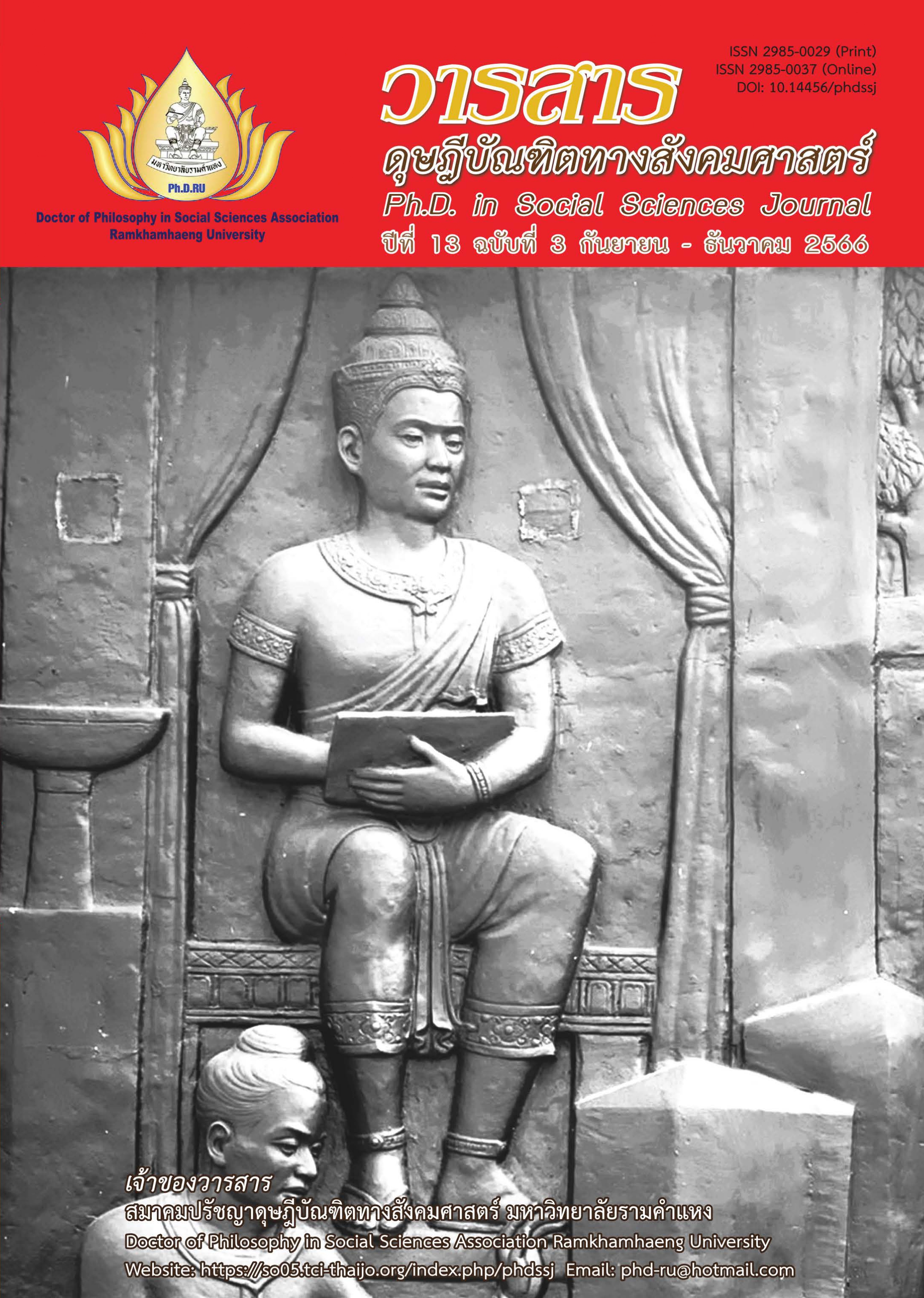การวิเคราะห์ผลกระทบจากการใช้จ่ายของรัฐในช่วงแผนพัฒนาเศรษฐกิจและสังคมแห่งชาติ ฉบับที่ 12 ด้วยแบบจำลองดุลยภาพทั่วไปเชิงสุ่มแบบพลวัต
Main Article Content
บทคัดย่อ
บทความวิจัยนี้มีวัตถุประสงค์เพื่อ (1) ศึกษาการเปลี่ยนแปลงค่าตัวทวีจากการใช้มาตรการทางการคลังของรัฐบาลด้วยแบบจำลองดุลยภาพทั่วไปเชิงสุ่มแบบพลวัต (2)วิเคราะห์ทางเลือกของมาตรการทางการคลังที่เหมาะสมจากการเปลี่ยนแปลงค่าตัวทวีสำหรับการกระตุ้นอุปสงค์มวลรวมในช่วงแผนพัฒนาเศรษฐกิจและสังคมแห่งชาติฉบับที่ 12 การวิจัยครั้งนี้ทำการวิเคราะห์ข้อมูลด้วยแบบจำลอง DSGE ตามแนวคิด NK Model และประมาณค่าพารามิเตอร์แบบเบส์ ผู้วิจัยทำการเก็บรวมรวมข้อมูลทุติยภูมิรายไตรมาสช่วงปี พ.ศ. 2560-2564 จากฐานข้อมูลออนไลน์ของหน่วยงานราชการที่เกี่ยวข้อง
ผลการวิจัย พบว่า การลดภาษีรายได้บุคคลธรรมดาและภาษีนิติบุคคล เป็นมาตรการทางการคลังที่ทำให้ตัวทวีการบริโภคครัวเรือนหาเช้ากินค่ำ และตัวทวีการลงทุนภาคเอกชน ซึ่งเป็นค่าตัวทวีที่ตอบสนองต่อการเปลี่ยนแปลงมาตรการทางการคลังในทางบวกมากที่สุดในระยะสั้น ระยะกลาง และระยะยาว ดังนั้น รัฐบาลหรือหน่วยงานที่เกี่ยวข้องควรเลือกใช้นโยบายการลดภาษีรายได้บุคคลธรรมดาและภาษีการบริโภคเพื่อกระตุ้นอุปสงค์มวลรวม
Article Details

อนุญาตภายใต้เงื่อนไข Creative Commons Attribution-NonCommercial-NoDerivatives 4.0 International License.
บทความวิชาการ บทความวิจัย และบทวิจารณ์หนังสือในวารสารดุษฎีบัณฑิตทางสังคมศาสตร์ เป็นความคิดเห็นของผู้เขียน มิใช่ของคณะผู้จัดทำ และมิใช่ความรับผิดชอบของสมาคมปรัชญาดุษฎีบัณฑิตทางสังคมศาสตร์ มหาวิทยาลัยรามคำแหง (กรณีการทำวิจัยในมนุษย์ ผู้วิจัยต้องผ่านการอบรมจริยธรรมการวิจัยในมนุษย์ และนำหลักฐานมาแสดง)
เอกสารอ้างอิง
Alesina, A., & Ardagna, S. (2010). Large changes in fiscal policy: Taxes versus spending. Tax Policy and the Economy, 24(1), 35-68.
Arnold, J. M., Brys, B., Heady, C., Johansson, A., Schwellnus, C., & Vartia, L. (2011). Tax policy for economic recovery and growth. The Economic Journal, 121(550), 59-80.
Bastian, J. E., & Jones, M. R. (2021). Do EITC expansions pay for themselves?: Effects on tax revenue and government transfers. Journal of Public Economics, 196(1), 104355.
Batini, N., Eyraud, L., & Weber, A. (2014). A simple method to compute fiscal multipliers. Retrieved from https://www.imf.org/external/pubs/ft/wp/2014/wp1493.pdf
Bawono, I. R., Halim, A., & Lord, B. (2012). Public sector performance measurement and budget allocation: An Indonesian experiment. Retrieved from https://ir.canterbury.ac.nz/bitstreams/e1e338a0-0d72-495e-b670-077589005a80/download
Blanchard, O. J., & Kiyotaki, N. (1987). Monopolistic competition and effects of aggregate demand. The American Economic Review, 77(4), 647-666.
Christiano, L., Eichenbaum, M., & Rebelo, S. (2011). When is the government spending?: Multiplier large. The Journal of Political Economy, 119(1), 78-121.
Christofzik, D. I., Fuest, A., & Jessen, R. (2022). Macroeconomic effects of the anticipation and implementation of tax changes in Germany: Evidence from a narrative account. Economica, 89(353), 62-81.
Coenen, G., Straub, R., & Trabandt, M. (2013). Gauging the effects of fiscal stimulus packages in the euro area. Journal of Economic Dynamics and Control, 37(2), 367-386.
Crul, M., Schneider, J., Keskiner, E., & Lelie, F. (2017). The multiplier effect: How the accumulation of cultural and social capital explains steep upward social mobility of children of low-educated immigrants. Ethnic and Racial Studies, 40(2), 321-338.
Delong, J. B., & Summers, L. H. (2012). Fiscal policy in a depressed economy. Brookings Papers on Economic Activity, 43(1), 233-297.
Drautzburg, T., & Uhlig, H. (2015). Fiscal stimulus and distortionary taxation. Review of Economic Dynamics, 18(4), 894-920.
Dudzevičiute, G., Šimelyte, A., & Liučvaitiene, A. (2018). Government expenditure and economic growth in the European union countries. International Journal of Social Economics, 45(2), 372-386.
Eggertsson, G. B. (2011). What fiscal policy is effective at zero interest rates?. NBER Macroeconomics Annual, 25(1), 59-112.
Gale, W. G., & Samwick, A. A. (2017). Effects of income tax changes on economic growth. In A. J. Auerbach & K. Smetters (Eds.). The economics of tax policy (pp. 13-39). Oxford University Press.
Gil, P., Martí, F., Morris, R., Pérez, J. J., & Ramos, R. (2019). The output effects of tax changes: Narrative evidence from Spain. SERIEs, 10(1), 1-23.
Harding, A. (2018). The effect of government transfer programs on low-income rates: A gender-based analysis, 1995 to 2016. Retrieved from https://epe.lac-bac.gc.ca/100/201/301/weekly_acquisitions_list-ef/2018/18-45/publications.gc.ca/collections/collection_2018/statcan/75f0002m2018003-eng.pdf
Kim, W. (2021). Macroeconomic effects of government transfer payments: Evidence from Korea. Economic Modelling, 102, 1-25.
López-Salido, J. D., & Rabanal, P. (2006). Government spending and consumption-hours preferences. Federal Reserve Bank.
Lucas, Jr., R. E. (1976). Econometric policy evaluation: A critique. In Carnegie-Rochester conference series on public policy (vol. 1, pp. 19-46). North-Holland.
Maipita, I. (2012). Simulasi pengeluaran pemerintah dan dampaknya terhadap kinerja ekonomimakro: Suatu model computable general equilibrium. Quantitative Economics Journal, 1(2), 1-15.
Munir, K., & Riaz, N. (2020). Macroeconomic effects of exogenous fiscal policy shocks in Germany: A disaggregated SVAR analysis. Revista Hacienda Publica Espanola, 233(2), 141-165.
National Statistical Office. (2022). Necessary statistical information for the region and province. Author. [In Thai]
Ono, Y. (2011). The Keynesian multiplier effect reconsidered. Journal of Money, Credit and Banking, 43(4), 787-794.
Ramsey, F. P. (1927). A contribution to the theory of taxation. Economic Journal, 37(145), 47-61.
Rotemberg, J. J. (1982). Sticky prices in the United States. Journal of Political Economy, 90(6), 1187-1211.
Shen, M. W., Yang, M. S. S., & Zanna, L. F. (2015). Government spending effects in low-income countries. International Monetary Fund.
Smets, F., & Wouters, R. (2003). An estimated dynamic stochastic general equilibrium model of the Euro area. Journal of the European Economic Association, 1(5), 1123-1175.
Sujianto, A. E., & Azmi, M. F. U. (2020). Associative study on government spending, inflation, trade balance, and gross domestic product. Ekuilibrium Jurnal Ilmiah Bidang Ilmu Ekonomi, 15(1), 27-37.
van der Wielen, W. (2020). The macroeconomic effects of tax changes: Evidence using real-time data for the European union. Economic Modelling, 90(1), 302-321.
Wu, S. Y., Tang, J. H., & Lin, E. S. (2010). The impact of government expenditure on economic growth: How sensitive to the level of development?. Journal of Policy Modeling, 32(6), 804-817.


